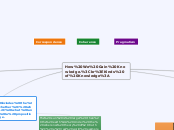по Cana Reuber 6 лет назад
889
Philosophy Mindmap
Pragmatism emphasizes the practical role of knowledge, focusing on how it serves our everyday needs and inquiries. It distinguishes between different types of knowledge, such as "knowledge-that,"

по Cana Reuber 6 лет назад
889

Больше похоже на это